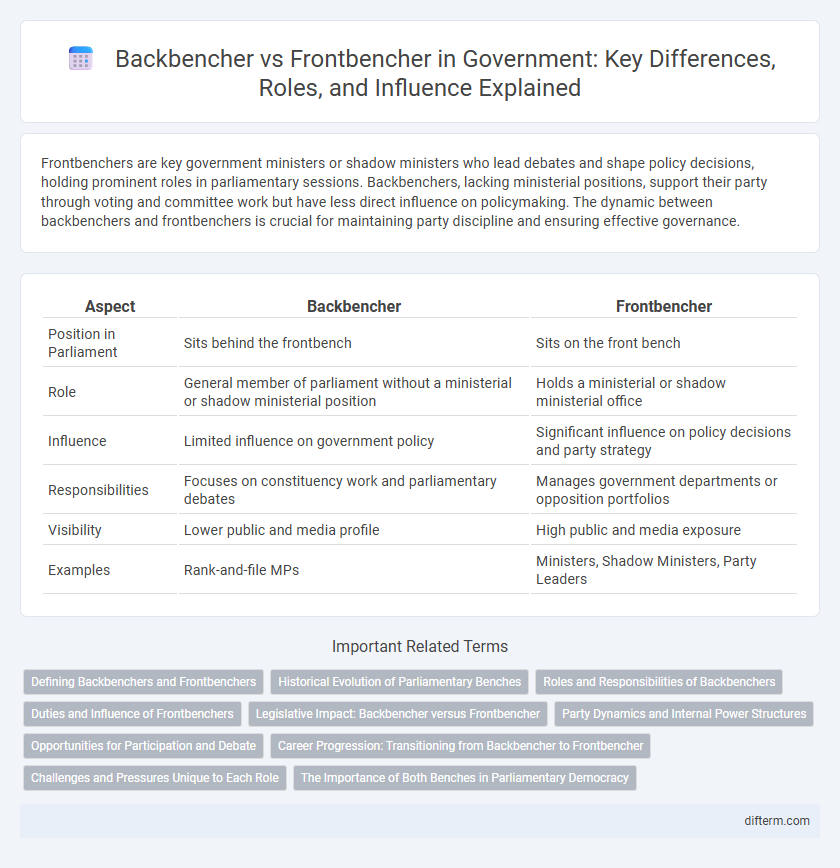Frontbenchers are key government ministers or shadow ministers who lead debates and shape policy decisions, holding prominent roles in parliamentary sessions. Backbenchers, lacking ministerial positions, support their party through voting and committee work but have less direct influence on policymaking. The dynamic between backbenchers and frontbenchers is crucial for maintaining party discipline and ensuring effective governance.
Table of Comparison
| Aspect | Backbencher | Frontbencher |
|---|---|---|
| Position in Parliament | Sits behind the frontbench | Sits on the front bench |
| Role | General member of parliament without a ministerial or shadow ministerial position | Holds a ministerial or shadow ministerial office |
| Influence | Limited influence on government policy | Significant influence on policy decisions and party strategy |
| Responsibilities | Focuses on constituency work and parliamentary debates | Manages government departments or opposition portfolios |
| Visibility | Lower public and media profile | High public and media exposure |
| Examples | Rank-and-file MPs | Ministers, Shadow Ministers, Party Leaders |
Defining Backbenchers and Frontbenchers
Backbenchers are members of parliament who do not hold ministerial positions or official party leadership roles, often sitting behind the frontbenchers in the legislative chamber. Frontbenchers include government ministers and shadow ministers who lead on policy areas, actively participate in debates, and shape party strategy. The distinction between backbenchers and frontbenchers reflects their differing levels of influence, responsibility, and visibility within government and opposition parties.
Historical Evolution of Parliamentary Benches
Parliamentary benches originated in the British House of Commons during the 14th century, where seating arrangements gradually reflected political hierarchy and influence. Frontbenchers initially included prominent ministers and party leaders who played direct roles in legislative decision-making, while backbenchers were rank-and-file Members of Parliament with less visible authority. Over time, this distinction evolved in various parliamentary systems worldwide, symbolizing the division between government leadership and regular members who contribute through committees and constituency representation.
Roles and Responsibilities of Backbenchers
Backbenchers in government primarily represent their constituents, contributing to legislative debates and serving on parliamentary committees without holding ministerial positions. Their roles include scrutinizing government policies, proposing amendments, and holding the executive accountable through questions and motions. Backbenchers maintain a crucial balance by influencing policy through advocacy and oversight while fostering party discipline and representing local interests.
Duties and Influence of Frontbenchers
Frontbenchers, typically senior members of the ruling party or opposition, hold key government or shadow cabinet positions that involve shaping policy, delivering speeches, and managing legislative agendas. Their duties include developing strategic decisions, representing the government in parliamentary debates, and overseeing specific departments or ministries. Frontbenchers wield significant influence by directing party strategy, influencing public policy, and guiding legislative priorities within the government or opposition.
Legislative Impact: Backbencher versus Frontbencher
Frontbenchers hold key ministerial or shadow ministerial roles, enabling them to directly influence legislative agendas and policy formulation within government and opposition alike. Backbenchers, while lacking formal leadership positions, impact legislation through participation in committees, debates, and by representing constituency interests, often shaping amendments and holding the executive accountable. The legislative effectiveness of frontbenchers often stems from their ability to drive agenda-setting, whereas backbenchers contribute by scrutinizing and refining proposed laws.
Party Dynamics and Internal Power Structures
Frontbenchers hold key leadership positions within the party, often serving as ministers or spokespersons, shaping policy and strategic direction. Backbenchers, while less influential in decision-making, play a crucial role in representing constituency interests and can impact party dynamics through voting behavior and internal debates. The balance between frontbenchers and backbenchers reflects internal power structures, affecting party cohesion and the government's ability to implement its agenda.
Opportunities for Participation and Debate
Frontbenchers hold key government or opposition roles, granting them priority access to parliamentary debates and significant opportunities to influence policy decisions. Backbenchers, while lacking formal leadership positions, can participate actively in committees, pose questions, and introduce private member's bills, fostering grassroots representation. The distinction between frontbenchers and backbenchers shapes the dynamics of parliamentary participation and the breadth of debate within legislative processes.
Career Progression: Transitioning from Backbencher to Frontbencher
Transitioning from backbencher to frontbencher requires demonstrating legislative expertise, party loyalty, and effective constituency representation to gain recognition among party leadership. Career progression often involves active participation in key parliamentary committees, developing strong policy knowledge, and networking within political circles to secure influential roles. Consistent performance and visibility in debates increase the likelihood of appointment to ministerial or shadow cabinet positions, marking the shift from a backbencher to a frontbench policymaker.
Challenges and Pressures Unique to Each Role
Backbenchers face challenges in gaining visibility and influencing policy without the privileges of leadership roles, often navigating limited access to key decision-making forums. Frontbenchers encounter pressures from managing portfolio responsibilities, maintaining party cohesion, and responding to heightened public and media scrutiny. Balancing individual convictions with party loyalty is a unique pressure impacting both roles differently within parliamentary dynamics.
The Importance of Both Benches in Parliamentary Democracy
Backbenchers play a crucial role in parliamentary democracy by representing constituency interests and holding the government accountable through questioning and debate. Frontbenchers, including ministers and shadow ministers, drive legislative agendas and policy formulation, providing leadership and direction within the government and opposition. The dynamic interaction between backbenchers and frontbenchers ensures robust governance, transparency, and diverse representation in decision-making processes.
Backbencher vs Frontbencher Infographic

 difterm.com
difterm.com